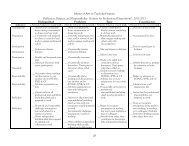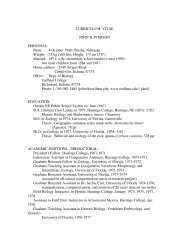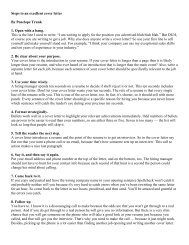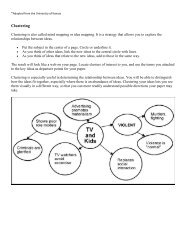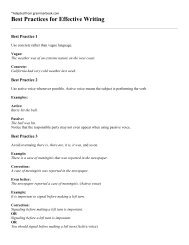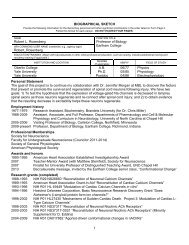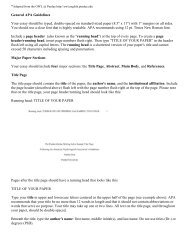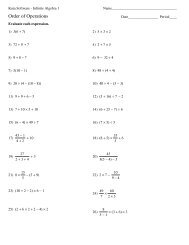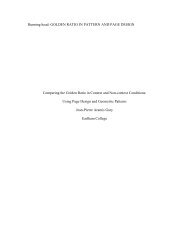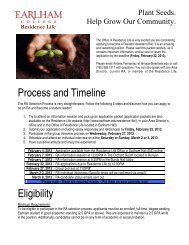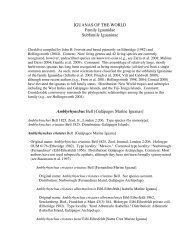Package
Package
Package
Create successful ePaper yourself
Turn your PDF publications into a flip-book with our unique Google optimized e-Paper software.
<strong>Package</strong><br />
with Care<br />
A Guide To Packing Your Shipments
Shipping Checklist<br />
Make sure you:<br />
❑ Use a rigid box with flaps intact.<br />
❑ Remove any labels, Hazardous Materials indicators,<br />
and other shipment markings from the box.<br />
❑ Wrap items separately.<br />
❑ Use adequate cushioning material.<br />
❑ Use strong tape designed for shipping.<br />
❑ Do not use string or paper over-wrap.<br />
❑ Use a single address label that has clear, complete<br />
delivery and return addresses.<br />
❑ Place a duplicate address label inside the box.<br />
NOTE: To prepare packages for UPS ® shipment, you can use<br />
your own packaging or containers available from UPS. We offer<br />
a variety of containers free of charge for UPS Air Services. We also<br />
offer corrugated cartons and packaging materials for purchase.<br />
UPS Packaging Supplies may be billed to your UPS account or<br />
a major credit card. Terms and conditions will apply. For either<br />
of these options, please visit “Supplies” at ups.com. ®
Step-by-Step<br />
Simply by observing a few basic principles when preparing<br />
your shipment, you can help ensure that your package<br />
travels safely to its destination. The four steps outlined<br />
here cover the key considerations in packing most articles<br />
with care.<br />
Step1<br />
Use a corrugated box.<br />
Use a new or “almost new”<br />
corrugated box. The more<br />
a box is used, the more it<br />
loses its original protective<br />
qualities and may not<br />
adequately protect your<br />
shipment. If you must<br />
reuse a box, make sure<br />
it is rigid and in excellent<br />
condition with no punctures,<br />
tears, rips, or corner damage, and that all flaps are intact.<br />
Shoeboxes, gift boxes, or other paperboard boxes are not<br />
recommended. Remove old address labels, Hazardous<br />
Materials indicators such as diamond labels and markings,<br />
as well as delivery markings and bar codes from the<br />
previous shipment.<br />
(BOX MANUFACTURER)<br />
THIS<br />
SINGLEWALL<br />
BOX MEETS ALL CONSTRUCTION<br />
REQUIREMENTS OF APPLICABLE<br />
FREIGHT CLASSIFICATION<br />
BURSTING<br />
TEST 200<br />
LBS PER<br />
SQ INCH<br />
MIN COMB<br />
WT FACINGS 84<br />
LBS PER<br />
M SQ FT<br />
BOX CERTIFICATE<br />
SIZE LIMIT<br />
75<br />
INCHES<br />
GROSS<br />
WT LT 65<br />
LBS<br />
(CITY<br />
&<br />
STATE)<br />
UPS ® recommends choosing a box strength<br />
that is suitable for its contents, based<br />
on the UPS Box Strength Guidelines.<br />
Never exceed the maximum gross<br />
weight limit for the box, which is printed<br />
on the Box Maker’s Certificate on the<br />
bottom flap of most boxes.<br />
After years of testing and analysis, engineers at the UPS<br />
Professional Services TM <strong>Package</strong> Lab (see page 11) have<br />
developed box strength specifications for single-package<br />
distribution. Refer to the chart on page 2 for recommendations<br />
in determining the proper size and maximum<br />
gross weight limit of a box.<br />
1
Step1<br />
Use a corrugated box. (cont.)<br />
Follow these steps when using the UPS Box Strength<br />
Guidelines chart to select the most appropriate box<br />
for your shipment.<br />
1. Weigh items to be shipped.<br />
2. Measure and add together the length, width,<br />
and height of the box.<br />
3. Select the appropriate row where the criteria<br />
in both columns A and B are met.<br />
4. Use column C to identify the recommended Bursting<br />
Test strength box. Or, use column D to identify the<br />
recommended Edge Crush Test strength box. At least<br />
one of these specifications can be found on the Box<br />
Maker’s Certificate.<br />
NOTE: A double-wall container should be used for an item(s)<br />
weighing more than 80 pounds.<br />
UPS Box Strength Guidelines<br />
A B C D<br />
Maximum<br />
Weight of Size Limit Bursting Edge Crush<br />
Contents of Box (inches) Test Test (ECT)<br />
(lbs.) L + W + H (lbs. per sq. in.) (lbs. per in. width)<br />
SINGLE-WALL CORRUGATED CONTAINERS<br />
30 75 200 32<br />
40 75 200 40<br />
50 85 250 44<br />
65 95 275 55<br />
80 105 350 NA<br />
DOUBLE-WALL CORRUGATED CONTAINERS<br />
60 85 200 48<br />
80 95 275 51<br />
100 105 350 61<br />
120 110 400 71<br />
140 115 500 82<br />
150 120 600 NA<br />
The above box strengths are only guidelines to help assure the<br />
containment and protection of products transported through<br />
single-package distribution environments. They are not to be<br />
considered packaging specifications, and all packaged products<br />
should be tested in accordance with industry-recognized performance<br />
tests to ensure the most appropriate level of product<br />
protection is achieved.<br />
2
Step2<br />
Provide internal protection.<br />
It’s important to cushion the<br />
contents of your package<br />
properly.<br />
Wrap each item separately.<br />
Fragile articles*<br />
need suitable separation<br />
from each other and<br />
from the corners, sides,<br />
top, and bottom of the<br />
box. Each item should<br />
be surrounded by at least<br />
two inches of cushioning and be placed at least two inches<br />
away from the walls of the box. This will prevent productagainst-product<br />
damage and protect the contents from<br />
shock and vibration which can pass from the outside of<br />
the box to the contents.<br />
Proper cushioning material, combined with a strong outer<br />
container, will protect your shipment. Use enough cushioning<br />
material to ensure that the contents cannot move<br />
when you shake the box. The following materials can be<br />
used for cushioning and protection:<br />
Air-encapsulated plastic (bubble pack)<br />
– Designed to protect and cushion lightweight items.<br />
– Use multiple wraps/layers to ensure product is<br />
completely protected, especially around corners<br />
and edges.<br />
Inflatable packaging (air bags)<br />
– Used primarily as void-fill material for lightweight<br />
items.<br />
– Can be preformed to provide proper cushioning<br />
performance for specific products.<br />
– Extreme hot or cold temperatures may affect<br />
the ability of air bags to provide adequate product<br />
protection.<br />
– Not recommended for items with sharp corners<br />
or edges.<br />
*Fragile objects – such as electronics, glass, ceramics, and artwork –<br />
may require special packaging for safe shipment; these packages<br />
may require added cushioning or a double box. For assistance<br />
with packing fragile objects, contact the UPS Professional<br />
Services <strong>Package</strong> Lab at package_testing@ups-psi.com or call<br />
1-877-877-7229.<br />
3
Step2<br />
Provide internal protection. (cont.)<br />
Expanded polystyrene “peanuts”<br />
– Used primarily as void-fill material for lightweight<br />
items.<br />
– Overfill the box with peanuts, then gently close<br />
the flaps and seal.<br />
– Due to the shifting and settling properties of peanuts,<br />
it is recommended that a minimum of three inches<br />
of cushioning be used around the contents.<br />
– Not recommended for use with flat, narrow, or dense<br />
products that may migrate to the edge or bottom<br />
of the carton during transit.<br />
Engineered foam enclosures<br />
– Should be preformed for specific products for proper<br />
cushioning performance.<br />
– Materials may include expanded polystyrene,<br />
polyethylene, polypropylene, or copolymers.<br />
Foam-in-place (a foam, sprayed into the box or mixed<br />
in packets, that expands and forms a protective mold<br />
around contents)<br />
– Provides good cushioning when foam is evenly<br />
distributed around the contents.<br />
– Select appropriate density of foam to meet packaging<br />
needs which can range from void-fill application to<br />
high-performance cushioning.<br />
Corrugated board<br />
– Can be laminated together to form blocks or pads,<br />
which are useful for blocking and bracing items inside<br />
the box.<br />
– Can also be die-cut, slit, or scored to form trays,<br />
partitions, or liners to increase package strength,<br />
improve performance, or separate items from each<br />
other within the package.<br />
– Not recommended for fragile items.<br />
4
Paper cushioning (multilayered paper padding) –<br />
not newspaper<br />
– Ideal for wrapping medium-to-large-sized, non-fragile<br />
items and those that may require moisture absorption.<br />
– Excellent for void fill.<br />
Crumpled kraft paper – not newspaper<br />
– Used primarily as a void-fill material for light-tomedium-weight,<br />
non-fragile items and items that<br />
are suitable for such packing materials.<br />
– To enhance performance, it is recommended that<br />
the paper be tightly crumpled.<br />
– Use at least four inches of paper around and between<br />
the contents. Ensure that there is at least four inches<br />
of packing on all six sides of the box.<br />
Clothing, blankets, and pillows are not proper cushioning<br />
materials.<br />
Step3 Close it securely.<br />
Proper closure is just as<br />
important as adequate<br />
cushioning.<br />
To close a box securely,<br />
apply three strips of<br />
tape to both the top<br />
and bottom of the box,<br />
so the middle and two<br />
edge seams are sealed<br />
(see illustration at right).<br />
Use a strong tape such as the types described below:<br />
Pressure-sensitive plastic or nylon-reinforced tape<br />
– Use a tape at least two inches or more in width.<br />
– Generally, the easiest, most convenient tape to use.<br />
It is versatile because it will adhere without water<br />
and can stick to a variety of surfaces and shapes.<br />
5
Step3 Close it securely. (cont.)<br />
Water-activated reinforced tape<br />
– Use 60-pound grade tape at least three inches wide.<br />
– Reinforced fibers in the tape provide additional<br />
strength, making it less susceptible to splitting<br />
or tearing.<br />
– Caution: Adhesion to the container may be affected<br />
by elements such as high humidity, wetness of tape,<br />
or dust.<br />
Do not use masking, cellophane, duct, or water-activated<br />
paper tapes; also, do not use string or paper over-wrap.<br />
Step4 Use proper labeling.<br />
For timely and accurate delivery, keep these points<br />
in mind when labeling your package:<br />
Always include the receiver’s<br />
ZIP Code ® with the complete<br />
address. For international<br />
shipments, include a<br />
contact name, telephone<br />
number, and postal code.<br />
Make every effort to obtain<br />
a street address. If you do<br />
use a P.O. box address, the<br />
recipient’s telephone number must be included on the<br />
label. A package addressed to a P.O. box may experience<br />
delays and will not be covered by any UPS Service<br />
Guarantee. An Address Correction charge also will apply.<br />
Army Post Office (APO) and Fleet Post Office (FPO)<br />
addresses are not accepted by UPS.<br />
Include the suite, apartment, or unit number,<br />
if applicable. Failure to do so may subject the shipper<br />
to an Address Correction charge.<br />
Place the shipping label on the top of the box. To avoid<br />
confusion, place only one address label on the box.<br />
If using a packing slip, place it on the same surface<br />
of the box as the address label.<br />
6
Do not place the label on a seam, edge, closure,<br />
or on top of sealing tape.<br />
Remove or cross out old labels or markings.<br />
Always include your complete return address including<br />
full street address and ZIP Code. For international<br />
shipments, include a contact name, telephone number,<br />
and postal code.<br />
Place a duplicate label or other form of address information<br />
inside the package.<br />
NOTE: If using a mailing tube, place the label horizontally,<br />
with the sides of the label pointing toward the ends of the tube,<br />
so the bar code can be scanned. If labeling an irregularly shaped<br />
item, make sure the label is placed on a flat surface to allow for<br />
scanning.<br />
NOTE: The smart labels produced by UPS OnLine WorldShip, ®<br />
UPS Internet Shipping, UPS CampusShip Ț M and UPS OnLine ®<br />
Compatible Vendor shipping systems include bar codes and<br />
routing codes that help ensure accurate routing and prompt<br />
delivery of your shipments. In addition, the use of smart labels<br />
allows for fast access to tracking and delivery information.<br />
Guidelines for <strong>Package</strong>s<br />
Weighing More Than 70 Pounds<br />
Packaging materials need to be evaluated carefully<br />
for packages weighing more than 70 pounds.<br />
Boxes need to be of strong construction, preferably<br />
with seams that are stitched or stapled, not glued.<br />
Check the strength of the box by checking the Box<br />
Maker’s Certificate to make sure the size limit and gross<br />
weight limit are not exceeded. For recommendations on<br />
determining the proper size and maximum gross weight<br />
limit of a box for individual package shipments, refer<br />
to the UPS Box Strength Guidelines chart in Step 1<br />
(page 2) of this brochure.<br />
Use new boxes whose strength has not been compromised<br />
by humidity or prior-use wear and tear.<br />
Seal with heavy-duty tape, preferably reinforced, by<br />
applying three strips to both the top and bottom of<br />
the box so the middle and two edge seams are sealed.<br />
7
011468<br />
•<br />
•<br />
•<br />
•<br />
•<br />
•<br />
•<br />
• • • • • • • • • • • • • • •<br />
•<br />
•<br />
•<br />
•<br />
•<br />
• • •• • • • • • • • • • • •••••• • • • • • •<br />
•<br />
•<br />
•<br />
•<br />
•<br />
•<br />
•<br />
•<br />
•<br />
Guidelines for <strong>Package</strong>s Weighing<br />
More Than 70 Pounds (cont.)<br />
Dense cushioning material is a must. Expanded<br />
polystyrene “peanuts” and crumpled paper are not<br />
acceptable because they crush and shift under heavy<br />
loads. Customized corrugated board or engineered foam<br />
enclosures are more suitable and reinforce the rigidity<br />
of the outer box.<br />
HEAVY PACKAGE<br />
WEIGHT<br />
lbs<br />
70 lbs+<br />
31.5 kg+<br />
A UPS Heavy <strong>Package</strong> sticker is required<br />
whenever you ship packages weighing more<br />
than 70 pounds. Place the sticker to the right<br />
of the address label, and write the package’s<br />
weight in the white box.<br />
Maximum <strong>Package</strong> Weight and Size<br />
The following weight and size limits apply to all packages<br />
shipped with all UPS service options except UPS SonicAir, ®<br />
unless otherwise indicated:<br />
The maximum weight is 150 pounds per package<br />
for domestic shipments.*<br />
The maximum size is 130 inches in length and girth<br />
combined.<br />
Step 1: Measure Girth<br />
Step 2: Measure Length<br />
GIRTH<br />
• • • • •<br />
•-•-•-•-•-•-•-•-•-•-•-•-•-•-•-•-•-•-•-•-•-•-•-•-•-•-•-•-•-•-•-•-•-•-•-•-•-•-•-•-•-•-•-•-•-•-•-•-•-•-•-•-•-•-•-•-•-•-•-•-•-•-•-•-•-•-•-•-•-•-•-•-•-•-•-•-•-•-•-•-•-•-•-•-•-•-•-•-•-•-•-•-•-•-•-•-•-•-•-•-•-•-•-•-•-•-•-•-•-•-•-•-•-•-•<br />
•• • • • • • • • • • • • • • • • • • • • • • • • • • • • • •<br />
• • • • • • • • • • • • • • • • • • • • • • • • • • • • •<br />
LENGTH<br />
•-•-•-•-•-•-•-•-•-•-•-•-•-•-•-•-•-•-•-•-•-•-•-•-•-•-•-•-••-•-•-•-•-•-•-•-•-•-•-•-•-•-•-•-•-•-•-•-•-•-•-•<br />
•• • • • • • • • • • • • • • • • • • • • • • • • • • • • • • • • • • • • • • • • • • • • • •<br />
-•-•-•-•-•-•-•-•-•-•-•-•-•-•-•-•-•-•-•-•-•-•-•-•-•-•-•-•-•-•-•-•-<br />
-•<br />
•<br />
•<br />
•<br />
• • • • • • • • • • • • • • • • • • • • • • • • • • • ••<br />
•<br />
•-•-•-•-•-•-•-•-•-•-•-•-•-•-•-•-•-•-•-•-•-•-•-•-•-•-•-•-•-•-•-•-•-•-•-•-•-•-•-•-•-•-•-•-•-•-•-•-•-•-•-•-•-•-•-•-•-•-•-•-•-•-•-•-•<br />
•••••••• ••••••••••••••••• •••• ••••••••• ••• • ••••••••••••••••••••••••<br />
Step 3: Add Length and Girth<br />
NOTE:<br />
– Girth is the distance all the way around the package or object<br />
at its widest point perpendicular to the length.<br />
– Length is the longest side of a package or object.<br />
*For international shipments, the maximum weight per package<br />
may vary by destination or origin. Contact the UPS International<br />
Customer Service Center at 1-800-782-7892 for details.<br />
*The maximum weight for a Hazardous Materials/International<br />
Dangerous Goods package (contractual service only) is 70 pounds,<br />
unless further restricted in the Guide for Shipping Ground and<br />
Air Hazardous Materials at ups.com. Call the UPS Hazardous<br />
Materials Support Center at 1-800-554-9964 for details.<br />
8
The maximum length is 108 inches. A package with<br />
the longest side measuring over 60 inches or the secondlongest<br />
side measuring over 30 inches in length will<br />
be subject to an Additional Handling Charge.<br />
<strong>Package</strong>s that exceed UPS weight and size limits are not<br />
accepted for transportation. If found in the UPS system,<br />
they are subject to an Over Maximum Limits charge.<br />
Billable Weight Determination<br />
The billable weight (actual, dimensional, or oversize<br />
weight, depending on the service selected) and the size<br />
of the box will affect the amount charged for shipping.<br />
Refer to ups.com ® or the UPS Rate and Service Guide for<br />
specifics on determining the billable weight of a package<br />
or shipment.<br />
Additional Handling Charge<br />
For domestic (U.S.) shipments, an Additional Handling<br />
Charge may be applied to the following:<br />
Any article that is encased in an outside shipping<br />
container made of metal or wood.<br />
Any cylindrical item, such as a barrel, drum, pail,<br />
or tire, that is not fully encased in a corrugated<br />
cardboard shipping container.<br />
Any package with the longest side exceeding<br />
60 inches or its second-longest side exceeding<br />
30 inches.<br />
UPS also reserves the right to assess the Additional<br />
Handling Charge for any package that, in UPS’s sole<br />
discretion, requires special handling.<br />
9
SHI PERS INTERNATIONAL<br />
(123) 456-7890<br />
5TH FL OR<br />
1 50 W ANYWHERE STR ET<br />
PHOENIX AZ 85027-3129<br />
SHIP<br />
TO:<br />
SHIPPERS INTERNATIONAL 12 LBS<br />
(123) 456-7890<br />
5TH FL OR<br />
1550 W ANYWHERE STR ET<br />
PHOENIX AZ 85027-3129<br />
JOHN SMITH<br />
(987) 654-3210<br />
ABC COMPANY<br />
BUILDING 3 FLOOR 4<br />
123 MAIN STREET<br />
SHIP<br />
TO:<br />
JOHN SMITH<br />
(987) 654-3210<br />
ABC COMPANY<br />
12 LBS 1 OF 2<br />
42084170 672<br />
1 OF 2<br />
12 LBS<br />
JOHN SMITH<br />
(987) 654-3210<br />
ABC COMPANY<br />
BUILDING 3 FL OR 4<br />
123 MAIN STR ET<br />
SHI PERS INTERNATIONAL<br />
(123) 456-7890<br />
5TH FL OR<br />
1 50 W ANYWHERE STR ET<br />
PHOENIX AZ 85027-3129<br />
SHIP<br />
TO:<br />
1 OF 2<br />
42084170 672<br />
Special Packaging Needs<br />
If you ship the following items, consider their special<br />
packaging needs:<br />
Irregularly shaped items and bare metals: Tape the<br />
address label on a flat surface of the item being shipped.<br />
Cover the label with clear tape. Do not use “flying tags.”<br />
Blunt all sharp or protruding edges with taped-on,<br />
corrugated cardboard pieces.<br />
Protect the surface of<br />
the item as needed.<br />
An Additional Handling<br />
Charge will apply.<br />
Fabric and wallpaper: Rolled goods travel best when<br />
shipped in corrugated boxes. If a fabric or wallpaper roll<br />
is shipped in a bag, it is recommended to use a bag with<br />
a minimum thickness of six mils. Make sure the bag is<br />
tightly wrapped and taped against the roll to reduce<br />
the risk of tearing. A tail on an item shipped in a bag<br />
must be compressed to the body of the item using tape.<br />
Place the address label on a flat surface of the item being<br />
shipped. Place duplicate<br />
address labels inside<br />
cores or between top<br />
layers of material.<br />
An Additional<br />
Handling Charge<br />
may apply.<br />
Tires: Apply a wide band of pressure-sensitive tape<br />
through the center and completely around the body<br />
of the tire so that the tape is attached to itself.<br />
Attach your address label to the tape<br />
band where it covers the tread.<br />
Cover the entire label with clear<br />
tape. An Additional Handling<br />
Charge will apply.<br />
BUILDING 3 FLOOR 4<br />
123 MAIN STREET<br />
SALT LAKE CITY UT 84170-6672<br />
UPS GROUND<br />
;;<br />
;;;;<br />
;;;;;;;;;;;;;<br />
;;;;;;;;;;;;;<br />
;;;;;;;;;;;;;<br />
;;;;;;;;;;<br />
SALT LAKE CITY UT 84170-6672<br />
UPS GROUND<br />
UT 841 0-00<br />
TRACKING #: 1Z 123 45E 03 1234 5671<br />
UT 841 0-00<br />
420841706672<br />
TRACKING #: 1Z 123 45E 03 1234 5671<br />
1Z 123 45E 03 1234 5671<br />
1Z 123 45E 03 1234 5671<br />
SALT LAKE CITY UT 84170- 672<br />
UT 841 0-00<br />
UPS GROUND<br />
TRACKING #: 1Z 123 45E 03 1234 5671<br />
1Z 123 45E 03 1234 5671<br />
10
An accelerometer was The attached resultant to g-force the front levels Requested of the are CRT as By: follows and John the (drops Doe monitor 1-6): was packaged in<br />
District: SNE<br />
the original packaging and subjected to instrumented drop testing. The monitor was dropped<br />
Region: Northeast<br />
in its normal orientation Drop (drops No. 1D-2D) N 2 Pressure and in a vertical g-force orientation (screen facing downward,<br />
drops 1E-2E) with the following 1 results: 110 PSI Product: 12 Computer Monitor – Model 123XYZ<br />
2 165 PSI 19 Breakage of the monitor (breakage defined as the<br />
<strong>Package</strong> Weight: 37 pounds Factory <strong>Package</strong>: Yes<br />
3 210 PSI 23 Test Laboratory monitor being unable to be powered up) occurred<br />
Drop No. Height g-force<br />
51-53 Drop Kenosia No. Avenue<br />
4 300<br />
Number<br />
PSI<br />
of Items:<br />
33<br />
1 Height g-force<br />
Capacity: N/A<br />
Danbury, CT at 06810 the 48 g-force level. A second monitor was tested<br />
1D 24" 5 350 36PSI 39 1E<br />
to narrow the<br />
24"<br />
g-level at which<br />
24<br />
damage can occur.<br />
2D 30" 6 400 Container 46PSI Style: 48 Regular 2E<br />
The results Slotted 30"<br />
are Container as follows (RSC) 36<br />
(drops 1B-3B):<br />
Normal Orientation Certification: 51 ECT Vertical Orientation<br />
Drop No. N 2 Pressure g-force<br />
Corrugation: Vertical Based CB-flute on the fragility testing results, damage can<br />
1B 220 PSI<br />
Testing Information Test Control Mfg’s Number: Joint:<br />
26<br />
Glued expect to occur at approximately 40 g’s in its normal<br />
2B 310 PSI An inspection 35 4952149<br />
Closure: Wide shipping Crown Staples orientation (Bottom) on a / 2" bottom PS Tape panel (Top) drop.<br />
International Safe Transit Association 3B 350 Additional PSI of the interior Testing 40<br />
Application: Performed Multiple (Bottom) / Multiple (Top)<br />
(ISTA) Project 1A Compression: components<br />
Dimensions: No Vacuum: 21 x 19.75 No x 20 (L x W x D, inches, OD)<br />
Vibration Time: minutes A wooden Bridged mold was Impact: fabricated of the Nomonitor<br />
Other:<br />
simulate N/A Torque: the monitor No being<br />
Frequency: CPM shipped in a vertical ECT: position revealed No and that Environmental: was subjected to Nofragility testing<br />
Drop Height: inches with the following Burst: results a heat Nosink<br />
Climatic: No<br />
Packaging<br />
(drops<br />
Description<br />
1C-4C):<br />
No. Of Drops: Burst Results: (yellow N/Aarrow)<br />
The is monitor positioned is contained in a poly bag and centrally<br />
Results<br />
Drop No. N Testing was terminated<br />
2 Pressure located close within proximity g-force the shipping container by four molded<br />
1C 350 expanded PSI to the CRT. polystyrene 41 (EPS) after edge the 4th protectors drop. The positioned<br />
See Appendix A for comments and recommendations. 2C 450 along PSI<br />
During<br />
the no.<br />
shipment<br />
1-5, 52 1-6, 3-5 monitor and 3-6 was edges. able to A molded be<br />
3C 550 EPS PSI<br />
in<br />
plank<br />
its normal<br />
is positioned 64 between powered the up, gimbal however and monitor<br />
4C 700 casing. PSI An instruction 82 manual the color and pattern power cord was are also<br />
orientation, downward movement of the packaged monitor can create a cantilever effect which<br />
contained in separate poly disrupted bags. as shown in the following example:<br />
can cause the CRT to come into contact with the heat sink and crack the circuit board. It is<br />
recommended that a diagnostics test be performed on the circuit board containing the heat sink<br />
to determine if this is the point of failure. An inspection of the bottom molded EPS foam edge<br />
protectors also revealed a low amount of load bearing area for the monitor (colored in blue)<br />
and a ridge along the bottom front edge protector (blue arrow) on which the gimbal is positioned<br />
which can allow shock forces to be directly transmitted to the monitor.<br />
Comments / Recommendations:<br />
To possibly prevent monitor damage, the following is recommended:<br />
For Lab Use Only: 2/3/97- (SLS)<br />
1. Redesign the heat sink so that there is a minimum 0.5" distance between the heat sink<br />
and CRT by either relocating the heat Before sink Testing or cutting away a section of the heat After sink Testing<br />
at a 45º angle to allow for the minimum 0.5" space distance.<br />
2. Redesign the foam edge protectors so that the monitor is shipped face down.<br />
3. Increase the amount of foam load bearing area for the bezel (when designing the packaging<br />
for the monitor to be shipped face down).<br />
4. Allow a minimum 0.75" clearance between the base of the gimbal and any packaging<br />
material (the molded EPS plank should remain to restrict the movement of the gimbal).<br />
Packaging Engineer Signature:<br />
<strong>Package</strong> Lab<br />
One UPS Way<br />
Hodgkins, IL 60525<br />
Customer: ABC Company<br />
A wooden mold was fabricated to duplicate the bottom molded<br />
EPS edge protectors and the monitor 123 was Main subjected Street to fragility<br />
Test Control Number: 4952149<br />
testing at incremental g-force levels in Anywhere, its normal USA shipping<br />
Date Tested: 2/3/97<br />
orientation (note: a new monitor was used for testing after each<br />
Shipper Number: 123456 Previous Test Number: N/A<br />
damage was detected).<br />
Previous Test Date: N/A<br />
(123) 456-7890<br />
5TH FL OR<br />
PHOENIX AZ 85027-3129<br />
JOHN SMITH<br />
SHIP<br />
TO:<br />
SHI PERS INTERNATIONAL<br />
(123) 456-7890<br />
5TH FL OR<br />
1 50 W ANYWHERE STR ET<br />
PHOENIX AZ 85027-3129<br />
SHIP<br />
TO:<br />
JOHN SMITH<br />
(987) 654-3210<br />
ABC COMPANY<br />
12 LBS 1 OF 2<br />
12 LBS<br />
1 OF 2<br />
42084170 672<br />
Bundled or strapped boxes: Only same-sized boxes<br />
may be strapped together. Use a minimum of four<br />
crisscrossed bands, two in each direction. An address<br />
label must be placed on each<br />
box. When strapping boxes<br />
together, each box must<br />
be strong enough to hold<br />
the total weight of the<br />
strapped bundle. For<br />
example, if two 40-pound<br />
boxes are banded together<br />
into an 80-pound package,<br />
both components should be<br />
in boxes with at least an 80-pound weight capacity.<br />
An Additional Handling Charge may apply.<br />
SHI PERS INTERNATIONAL<br />
1 50 W ANYWHERE STR ET<br />
(987) 654-3210<br />
ABC COMPANY<br />
BUILDING 3 FLOOR 4<br />
123 MAIN STREET<br />
SALT LAKE CITY UT 84170-6672<br />
UT 841 0-00<br />
BUILDING 3 FLOOR 4<br />
123 MAIN STR ET<br />
SALT LAKE CITY UT 84170-6672<br />
UPS GROUND<br />
UPS GROUND<br />
UT 841 0-00<br />
420841706672<br />
TRACKING #: 1Z 123 45E 03 1234 5671<br />
TRACKING #: 1Z 123 45E 03 1234 5671<br />
1Z 123 45E 03 1234 5671<br />
1Z 123 45E 03 1234 5671<br />
UPS Professional Services TM<br />
<strong>Package</strong> Lab<br />
The UPS Professional Services <strong>Package</strong> Lab helps<br />
customers find effective and cost-efficient packaging<br />
for products. Packaging engineers evaluate the<br />
current or proposed package, conduct a variety<br />
of industry-accepted tests, and prepare a written<br />
report that recommends modifications to improve<br />
performance, economy, and efficient use of materials.<br />
The package lab also monitors the latest developments<br />
in package-testing research worldwide. Contact<br />
your UPS account executive or the package lab<br />
at package_testing@ups-psi.com, or call<br />
1-877-877-7229 for details.<br />
Appendix A (con’t)<br />
Laboratory Test Report<br />
Appendix A<br />
11
Special Restrictions<br />
Restrictions apply to the shipping of certain items, such<br />
as firearms, ammunition, fireworks, hazardous materials,<br />
Other Regulated Materials (ORM-D), hazardous waste,<br />
international dangerous goods, alcoholic beverages,<br />
international jewelry shipments, live animals, perishable<br />
commodities, and articles of unusual value (as defined<br />
in the UPS Tariff at ups.com).<br />
Shippers are prohibited from shipping, and UPS does not<br />
accept for transportation, articles having a value of more<br />
than $50,000. Additionally, more restrictive value limits<br />
apply to packages shipped as a result of a request for<br />
service made through the Internet by a shipper who has<br />
a UPS Internet Shipping account only; packages returned<br />
via Print Return Label, Print and Mail Return Label,<br />
Electronic Return Label, or 1 UPS Pickup Attempt Return<br />
Services; packages shipped via a UPS Letter Center;<br />
and Prepaid Letters.<br />
For complete information on maximum liability, refer<br />
to the Terms and Conditions of Service and the UPS Tariff<br />
at ups.com. Call 1-800-PICK-UPS ® or visit ups.com for<br />
guarantee details, service availability, and delivery-time<br />
commitments.<br />
Packaging Responsibility<br />
It is the responsibility of the shipper to ensure that proper<br />
packaging is used and that the contents of packages are<br />
adequately and securely packed, wrapped, and cushioned<br />
for transportation. The use of packaging provided by UPS,<br />
or of packaging purchased from UPS, is not a guarantee<br />
that an item is sufficiently packaged for transportation.<br />
UPS does not provide special handling for packages<br />
bearing “Fragile,” package orientation markings (e.g.,<br />
“UP” arrows or “This End Up” markings), or any other<br />
similar such markings.<br />
Prohibited by Law<br />
No service shall be rendered by UPS in the transportation<br />
of any shipment that is prohibited by applicable law or<br />
regulation of any federal, state, provincial, or local government<br />
in the origin or destination country.<br />
12
Helpful Hint<br />
Your packages move through the global UPS distribution<br />
system smoothly when you use smart labels. With a<br />
series of scans, essential information about your packages<br />
is provided to UPS. Smart labels:<br />
Include routing codes to help ensure prompt delivery<br />
of your shipments.<br />
Provide quick access to tracking and delivery<br />
information.<br />
Save you time by eliminating handwritten labels.<br />
Can be produced using UPS OnLine WorldShip, ®<br />
UPS Internet Shipping, UPS CampusShip Ț M and<br />
UPS OnLine ® Compatible Vendor shipping systems.<br />
“Greener” Packaging<br />
UPS conducted a joint project with the Alliance for<br />
Environmental Innovation to improve the environmental<br />
profile of UPS-provided packaging. The project<br />
yielded natural resource conservation, energy savings,<br />
and reductions in solid waste through the addition of<br />
post-consumer recycled content, material substitution<br />
and reduction, and paperboard and plastic reformulation.<br />
UPS is the industry leader in environmentally<br />
preferable performance-oriented packaging.
1-800- P I C K- U P S ®<br />
ups.com ®<br />
WHAT CAN BROWN DO FOR YOU? SM<br />
© Copyright 2002, United Parcel Service of America, Inc. All rights reserved.<br />
01921115 8/02 10% post-consumer content



